Animation &Commentary &SpornFilms 10 Jan 2008 09:45 am
Tyer Breaking Joints
- Let’s talk about the breaking of joints. No, I haven’t entered Tony Sopranoland. This is an animation blog, so I’m obviously talking about the animation principle that deals with the “breaking of joints” to create any arcs or curves in animation. All human action is controlled by this method of movement. A body can only bend at joints – knees, wrists, elbows etc. Any other break is artificial and verboten in trying to make your character seem real. Any animator of the human form would swear by it.
Here’re four pages from Dick Williams’ book which illustrate the principle. Though if you look at his book – all those walks, all those bent wrists – this is one of the backbones of Dick’s training/education.
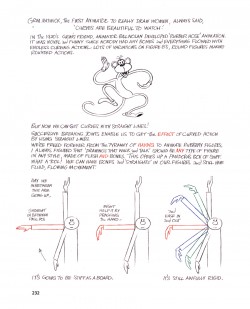 1
1 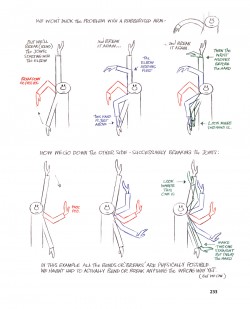 2
2
___(Click any image to enlarge.)
_
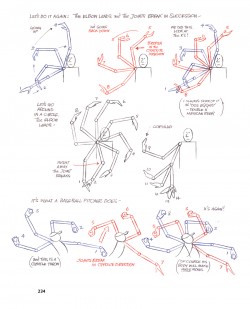 3
3 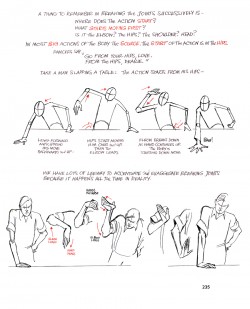 4
4
This is something I learned early on – long before I entered the business professionally.
I wasn’t sure it was spelled out in the Preston Blair book and went back to see, but it wasn’t. I don’t know where I originally read about it, but I must have somewhere – probably one of those old animation books I’d borrow from the library.
I’m sure they created it when animators at Disney in the early 30′s decided to get rid of the rubber-hose animation they’d been doing. It was a bit of rebellion. They followed the natural rules of physics. Today anything other than this would be the rebellion.
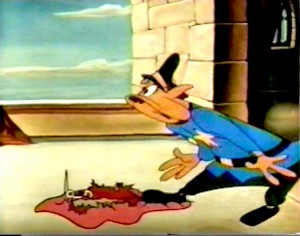 The one guy who broke this rule, and is just about idolized for it today, is Jim Tyer. His many distortions and odd working of his characters was an end in itself. This is probably what I liked about him.
The one guy who broke this rule, and is just about idolized for it today, is Jim Tyer. His many distortions and odd working of his characters was an end in itself. This is probably what I liked about him.
I’ve always seen animation as a way to caricature life not to recreate it.
Sidenote: This is why I don’t like most cgi films. They’re just trying to reproduce their form of life. Sure, Surf’s Up got those waves down pat; it’s almost perfect. Unless, of course, you’re looking for them to say something about waves rather than realistically rendering them and their movement.
Sorry, I respect it, but it’s like super-realistic painting done today; I have difficulty getting into it.
Animation is drawn. Drawing invites nonsense – even in the most serious of situations.
Tyer uses his graphic distortions to make scenes funny. In Fritz the Cat he handled some serious scenes with a quieter distortion, though it’s there just the same. It’s the acknowledgement that we’re watching an animated film that gets me charged. I like being in the moment and outside of it all at the same time.
Does that make sense?
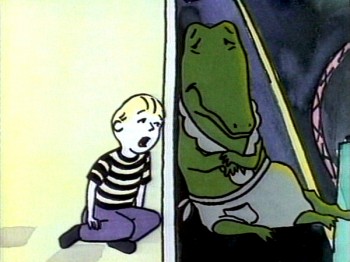 Lyle Lyle Crocodile was about a housekeeping, dancing crocodile that shares his house with a child. When his original owner comes to take Lyle away, the child gets upset, sings a song of remorse and cries. Lyle hides in a broom closet while the child sings from the other side of the door. I chose to view this as a cartoon. For god’s sake, it’s a cartoon crocodile that dances! For anyone who wants to see it, I’m mocking the situation. Visions of candy canes and ice cream cones dance around the croc’s head as he remembers the good days. I asked the composer to use a harmonica and a saxophone to pull the tears. Every time I see the scene I laugh hysterically. Most audiences don’t see this, and they weep for the boy and his pet.
Lyle Lyle Crocodile was about a housekeeping, dancing crocodile that shares his house with a child. When his original owner comes to take Lyle away, the child gets upset, sings a song of remorse and cries. Lyle hides in a broom closet while the child sings from the other side of the door. I chose to view this as a cartoon. For god’s sake, it’s a cartoon crocodile that dances! For anyone who wants to see it, I’m mocking the situation. Visions of candy canes and ice cream cones dance around the croc’s head as he remembers the good days. I asked the composer to use a harmonica and a saxophone to pull the tears. Every time I see the scene I laugh hysterically. Most audiences don’t see this, and they weep for the boy and his pet.
This is what I love. Something for me and something for people who don’t want that extra bit of separation. It’s actually a hard thing to pull off, but it’s great when you do.
The same bit is true about the breaking of joints. In every film, I go out of my way to break that rule and see if it’s noticeable. I’m not even trying to be as blatant as Jim Tyer. To be honest, I don’t think it is noticeable, although I see it every time. Tissa David hates when I do such things, but I can’t help it. I love the graphic distortions animation encourages, but I also love the rules of behaviour that help me tell staid stories. Hey, it’s great being the boss of me.

on 11 Jan 2008 at 3:50 pm 1.Eddie Fitzgerald said …
Very Nice to be reminded of Williams’ ideas on breaking joints! His book was underrated when it came out and I’d be surprised if he made serious money on it. It was just his gift to the industry that he loved. I imagine that’s how you think of this blog.
Your comment on liking to be inside the moment and outside it at the same time was great! I never heard that thought articulated so well. Eddie Fitzgerald
on 13 Jan 2008 at 12:07 am 2.Michael said …
I think, in a way, all art is about breaking the rules, but you have to know the rules inside and out, backwards and forwards before you can break them. Otherwise, you’re simply justifying your inability to do live by them.
on 10 Dec 2008 at 5:25 am 3.nic said …
Hi, I enjoyed your blog post, thanks alot